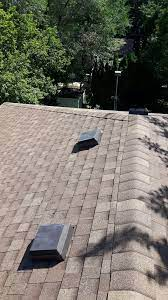Chapter E6 – Installs Roofing Components
Key Competencies
The NOA for Carpenter (2013) also identifies the required competencies for the task of installing roofing components. These include:
- Select and use tools and equipment such as staplers, chalk lines, knives, metal shears and hammers
- Select roof venting products according to location, specifications, and type and size of roof
- Select strapping according to specifications and product requirements
- Select flashing such as drip edges, step flashing and cap flashing according to location, specifications, and type of roof
- Apply underlayment materials to prevent damage such as ice damming and water penetration
- Apply flashing components using fasteners and sealants, according to manufacturers’ specifications, to direct water and prevent moisture penetration
- Mount roof ventilation components such as ridge vents and exhaust vents according to manufacturers’ specifications
- Install skylights according to manufacturers’ specifications (NOA, p. 58).
Common Roof Coverings
Roof coverings can be made from the following materials:
- Asphalt
- Wood
- Metal
- Asbestos cement
- Ceramic
- Glass
- Concrete
- Plastic
As warm air in improperly vented attic spaces meets with cooler air at the eave moisture is released which then freezes causing ice buildup. In many instances eave protection is required by code to prevent water infiltration caused by ice buildup. Underlay is installed to protect the roof sheathing from moisture penetration.
The type of fastener is usually determined by the roof covering product being installed. Roofing nails and staples are common for asphalt and wood products, but screws are typically used on metal roofs. Flashing will be required for any valleys and roof penetrations including venting, plumbing stacks, chimneys, skylights and sidewalls. Roof ventilation is installed near the ridge based on NBC requirements. A ridge cap is installed to cover the hip and ridge.

Source: https://c2roofing.ca/
Estimating roofing materials is based off the total roof area or number of squares. Exposure is factored into the amount of roof area a bundle of shingles will cover by the manufacturer. Typically, one bundle will cover 32 SF of roof area. Along with the area and perimeter, knowing the roof slope, roof overhang, building length and width will help determine the amount of roofing materials needed for a project.
For roofing terminology, diagrams and additional information on roofing materials review:
- Carpentry “Asphalt Shingles and Tile Roofing,” (Chapter 55) and “Wood Shingles and Shakes” (Chapter 56)
- Principles and Practices of Commercial Construction “Roof Membranes and Insulation (P 463-478)
Review on Brightspace:
ROOF 200/220 Roof Coverings:
- IS 1.2 Roof Covering Materials, p. 1-15.
Review Questions
- Name the three common materials used for residential roof coverings.
- How many layers of asphalt material make up a shingle?
- What does “exposure” mean?
- It is advisable to use a 400-450 mm strip of _______ in areas where wind-driven snow or rain may enter between shakes.
- Where should flashing be used?
- What is a cricket?
- Eave protection extends from _____ to _______.
- What are some materials that may be used for eave protection?
- What head diameter should nails have for:
- Asphalt roof coverings
- Wood roof coverings
Answers:
- Asphalt, cedar shakes, cedar shingles
- Three layers
- Exposure refers to the amount the material is exposed to the elements.
- Breather-type building paper
- At the junction of roofs and walls, where two roof lines intersect to form a valley, where stack vents penetrate the roof, and where chimneys are located.
- A special sloped flashing placed behind chimneys on the roof slope.
- The edge of the roof a minimum of 900 mm up the slope to 300 mm inside the inner face of the exterior wall. (9.26.5.1)
- No. 15 asphalt-saturated felt; type M or S roll roofing, glass fibre or polyester fibre sheets; modified bituminous coated material
-
- 9.5 mm
- 4.8 mm (9.26.2.2)
